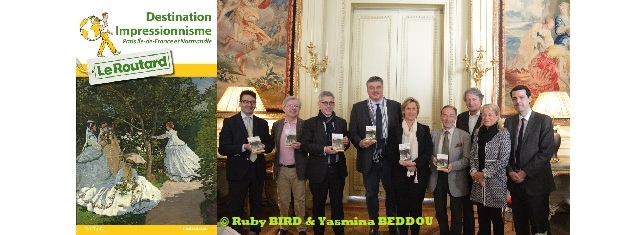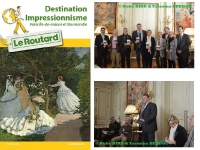Arts
Impressionism Paris-Isle-de-France and Normandie by Le Routard Guide
Numerous paintings around 10 routes

(Source: Guide du Routard - Ruby BIRD & Yasmina BEDDOU)
USPA NEWS -
Le Routard offers to the public, in partnership with the two régions Paris Isle-de-France and Normadie, an exiting guide putting ahead those two visiting destinations through impressionist paintings. You can follow impessionist painters via 10 routes. The guide was released on April 13, 2016...
Le Routard offers to the public, in partnership with the two régions Paris Isle-de-France and Normadie, an exiting guide putting ahead those two visiting destinations through impressionist paintings. You can follow impessionist painters via 10 routes. The guide was released on April 13, 2016.
Page after page, an entire artistic era comes back to life : Monet in Le Havre, Rouen, Giverny and Paris ; Millet in Le Cotentin and Barbizon ; Caillebotte in Yerres ; Van Gogh in Auvers-sur-Oise ; Boudin in Honfleur and Deauville ; Berthe Morisot in Fécamp and Bougival ; Renoir in Montmartre and Chatou...
Page after page, an entire artistic era comes back to life : Monet in Le Havre, Rouen, Giverny and Paris ; Millet in Le Cotentin and Barbizon ; Caillebotte in Yerres ; Van Gogh in Auvers-sur-Oise ; Boudin in Honfleur and Deauville ; Berthe Morisot in Fécamp and Bougival ; Renoir in Montmartre and Chatou...
A Press Conference was given on April 19, 2016 at the Musée Jacquemart-André (Paris). Were attending personalities, with among them, making a speech :
- David Douillet : retired French judoka and politician and he was born in the city of Rouen. He won the judo heavyweight gold medals in the 1996 and 2000 Olympic Games in Atlanta and Sydney. He also gained four world titles and a European crown. These achievements make him one of the most decorated judoka in history.
- Philippe Gloagen : Director of Le Guide du Routard
- Jacques-Sylvain Klein : Art Historian, Curator, Commissioner General of 1st 'Festival Normandie Impressionniste'.
- David Douillet : retired French judoka and politician and he was born in the city of Rouen. He won the judo heavyweight gold medals in the 1996 and 2000 Olympic Games in Atlanta and Sydney. He also gained four world titles and a European crown. These achievements make him one of the most decorated judoka in history.
- Philippe Gloagen : Director of Le Guide du Routard
- Jacques-Sylvain Klein : Art Historian, Curator, Commissioner General of 1st 'Festival Normandie Impressionniste'.
Impressionism is a 19th-century art movement that originated with a group of Paris-based artists whose independent exhibitions brought them to prominence during the 1870s and 1880s. Impressionist painting characteristics include relatively small, thin, yet visible brush strokes, open composition, emphasis on accurate depiction of light in its changing qualities, ordinary subject matter, inclusion of movement as a crucial element of human perception and experience, and unusual visual angles
The development of Impressionism in the visual arts was soon followed by analogous styles in other media that became known as impressionist music and impressionist literature. By recreating the sensation in the eye that views the subject, rather than delineating the details of the subject, and by creating a welter of techniques and forms, Impressionism is a precursor of various painting styles, including Neo-Impressionism, Post-Impressionism, Fauvism, and Cubism.
The term Impressionist quickly gained favour with the public. It was also accepted by the artists themselves, even though they were a diverse group in style and temperament, unified primarily by their spirit of independence and rebellion. The development of Impressionism can be considered partly as a reaction by artists to the challenge presented by photography, which seemed to devalue the artist's skill in reproducing reality. Both portrait and landscape paintings were deemed somewhat deficient and lacking in truth as photography 'produced lifelike images much more efficiently and reliably'.
The main Impressionists are :
- Frédéric Bazille (who only posthumously participated in the Impressionist exhibitions) (1841““1870)
- Gustave Caillebotte (who, younger than the others, joined forces with them in the mid-1870s) (1848““1894)
- Mary Cassatt (American-born, she lived in Paris and participated in four Impressionist exhibitions) (1844““1926)
- Paul Cézanne (although he later broke away from the Impressionists) (1839““1906)
- Edgar Degas (who despised the term Impressionist) (1834““1917)
- Armand Guillaumin (1841““1927)
- Frédéric Bazille (who only posthumously participated in the Impressionist exhibitions) (1841““1870)
- Gustave Caillebotte (who, younger than the others, joined forces with them in the mid-1870s) (1848““1894)
- Mary Cassatt (American-born, she lived in Paris and participated in four Impressionist exhibitions) (1844““1926)
- Paul Cézanne (although he later broke away from the Impressionists) (1839““1906)
- Edgar Degas (who despised the term Impressionist) (1834““1917)
- Armand Guillaumin (1841““1927)
- Édouard Manet (who did not participate in any of the Impressionist exhibitions) (1832““1883)
- Claude Monet (the most prolific of the Impressionists and the one who embodies their aesthetic most obviously) (1840““1926)
- Berthe Morisot (1841““1895)
- Camille Pissarro (1830““1903)
- Pierre-Auguste Renoir (1841““1919)
- Alfred Sisley (1839““1899)
...
Source : Le Guide du Routard
Ruby BIRD
http://www.portfolio.uspa24.com/
Yasmina BEDDOU
http://www.yasmina-beddou.uspa24.com/
- Claude Monet (the most prolific of the Impressionists and the one who embodies their aesthetic most obviously) (1840““1926)
- Berthe Morisot (1841““1895)
- Camille Pissarro (1830““1903)
- Pierre-Auguste Renoir (1841““1919)
- Alfred Sisley (1839““1899)
...
Source : Le Guide du Routard
Ruby BIRD
http://www.portfolio.uspa24.com/
Yasmina BEDDOU
http://www.yasmina-beddou.uspa24.com/
Ruby Bird Yasmina Beddou Le Routard Guide Isle De France Normandie Pantings Impressionism Monet Millet Van Gogh Berthe Morisot Renoir Havre Rouen Paris Montmartre
Liability for this article lies with the author, who also holds the copyright. Editorial content from USPA may be quoted on other websites as long as the quote comprises no more than 5% of the entire text, is marked as such and the source is named (via hyperlink).






